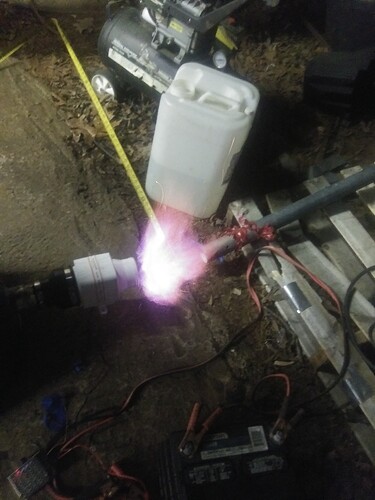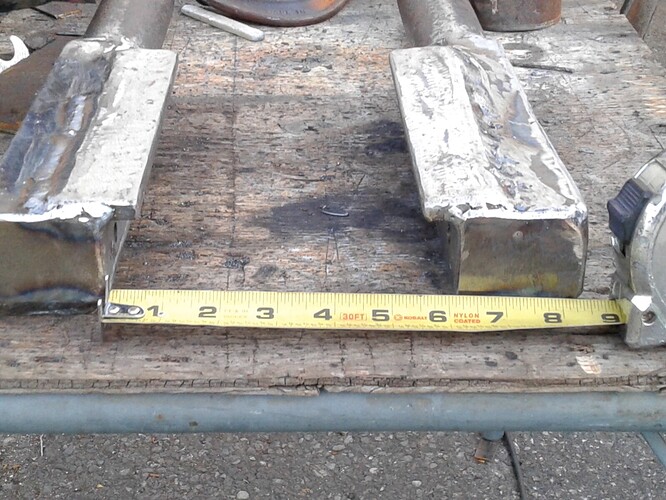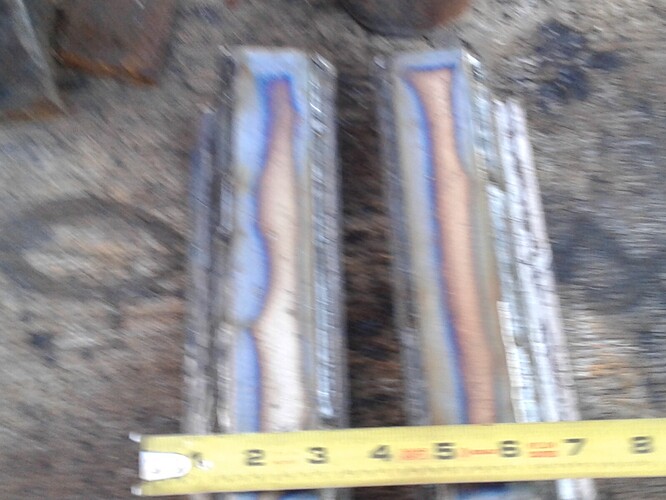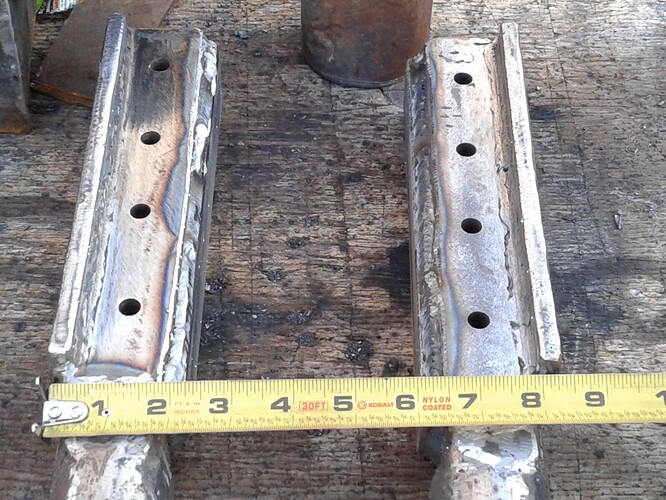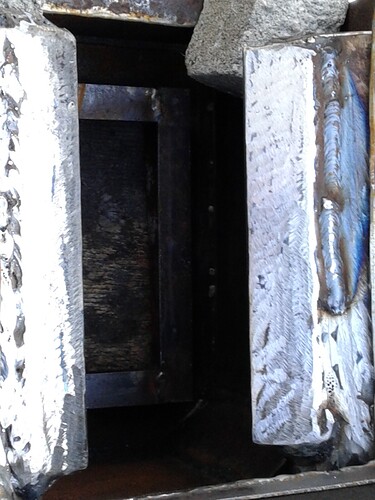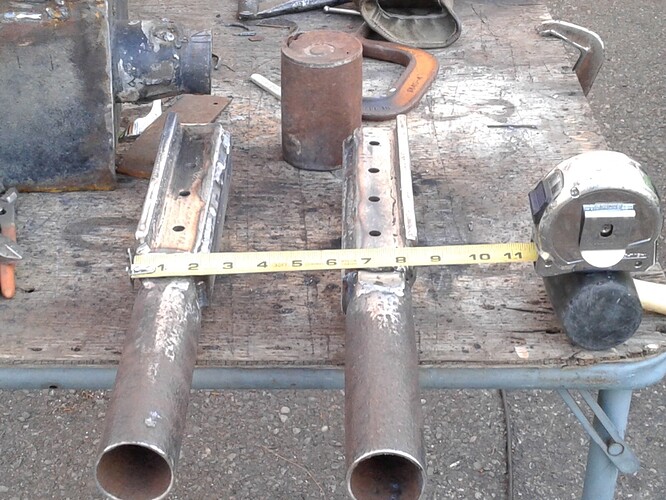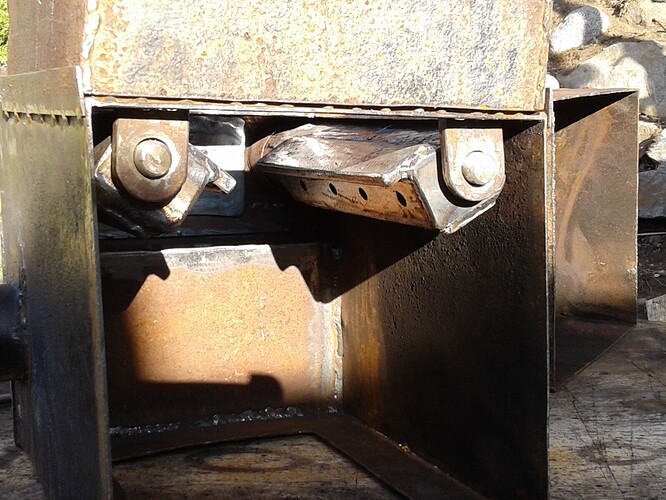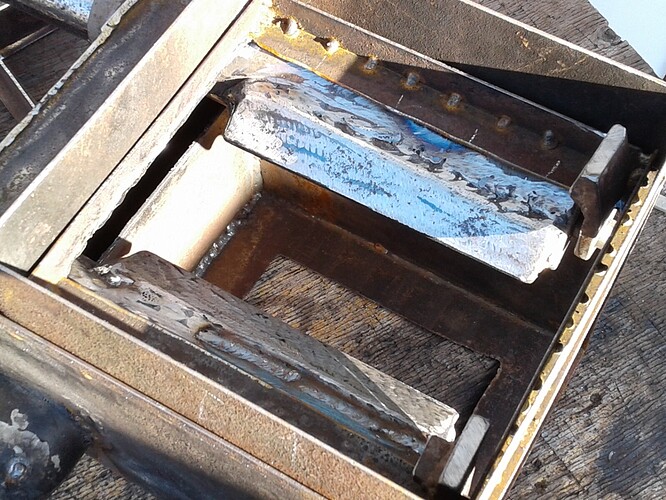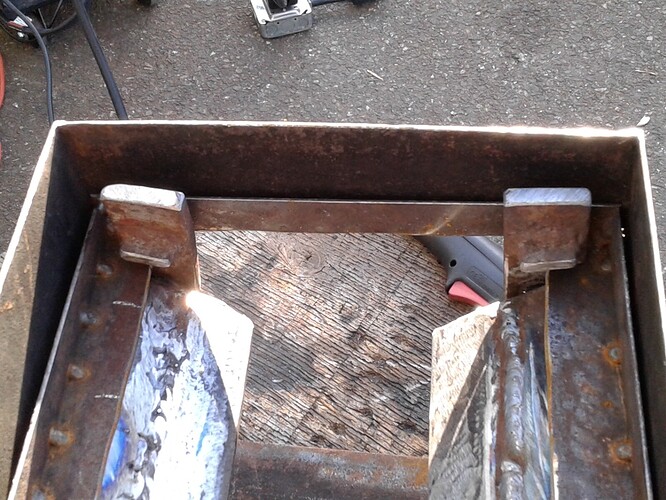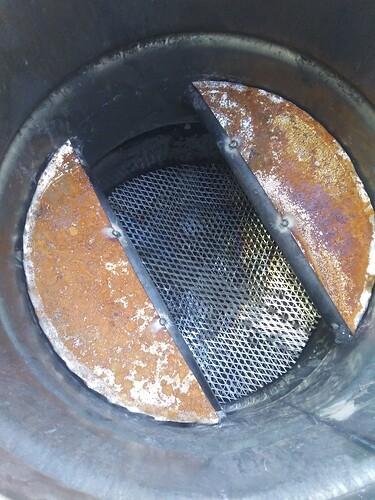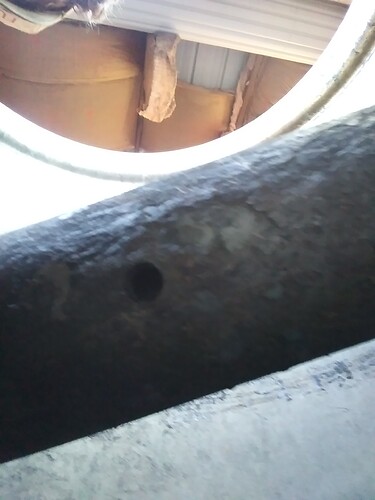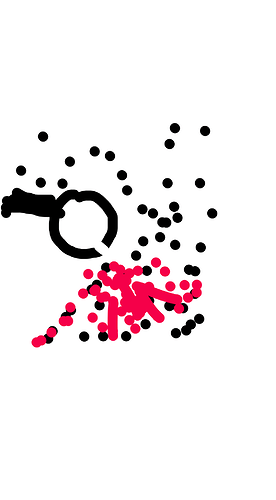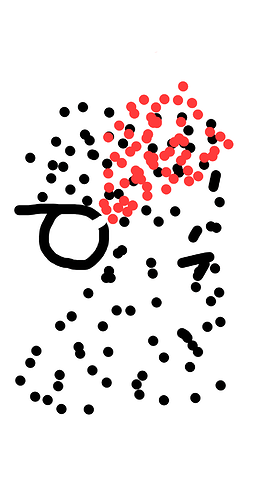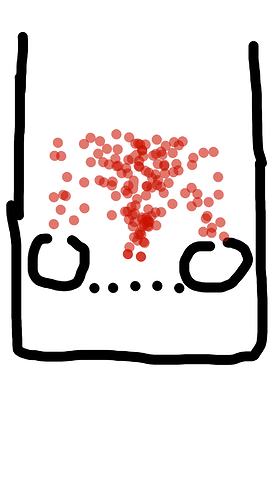Posted it in my build for the Mazda but I’ll go ahead and repost here since it’s relevant. Mine is working pretty good, I bet Bob’s will be nicer.
I like it, yours is simple, a double flute simple fire gasifer.
Bob
Up date 37- 4521btwhatever.
The wind just would not stop so I turn up the gas shielding higher and welded anyways. Not Pretty welds but strong welds.
You can see the heavy duty over roof hangs I put on top of the flutes per @gasman Max’s idea for protection of the nozzles. It also added more mass to the flute nozzles.
The picture is blurry, the bottom has more heat sink mass.
These flutestubes are getting heavy.
Flutes in place with a clearance gap of 3 3/4" or 9.525 cm for charcoal to flow through I can make the gap closer if needed.
The long tubes will act like a heat sink with cold air coming in. On the other side I have decided again to put a hatch cover in so the tubes can be removed. It will be attached solid to the hatch cover with heat sink fins on the out side. The hatch will be air tight, with heat shielding around it. Over kill? Hey I have already passed that.
The way I am building it we might have to call it a WK double flute gasifer.
I can still lift it up off the ground, with out grunting.
Bob
Edit: In the picture is another old lead dot sealed can I found in the holler for you southern boys or gully for us northern boys. All these places were checked and worked by gold prospectors in the late 1890’s thru up to today on the Columbia River. They stoped making these tin cans like this around 1920. That a 100+ year old tin can just sitting out in this open environment on top of the ground.
Bob
My flutes ended up being about 25 pounds each. I still need to make a water drip or mist system for it. I didn’t get the tubes terribly level so right now they come in one side and glide to the other if I pour a splash of water in.
Cody, I think that is good not to have them level so water can’t lay inside when shut down, with the water drip still on. If the water goes out the nozzles you now have a soaked charcoal bed and flooded gasifer.
Bob
I made it heavy duty. There will be a flute nozzles removal hatch so I can make changes in the nozzles design if I need to.
When the nozzles are at 90° and facing each other there is 5" or 12.7 cm between them. When pointing down there is 5.75" or 14.6 cm. A little change not much.
The nozzles are in place with the holding brackets that are removable and will lock in place. There is a 90° to 60° angle change on the nozzles surface face. 60° is pretty steep downwards direction.
Bob
Ok Kristijan. What happens when the ashtray is to be cleaned? all the fire tube (made of ash and charcoal) must be destroyed
and rebuilt every time?
Maybe this design is only for experimentation?
I’m finding with my build that the flutes are getting way too hot. Hot enough to start scaling off slowly. I haven’t zeroed out all of the variables so that will have to wait until my next test flare. I’m hoping with the shelves I put in will only allow the char to go past the nozzle holes and not slip around the non burning end.
Has anyone had these temp issues with a crossdraft charcoal build?
Yes Cody I did have some heat problems on my heat shielding above my nozzle, the heavy steel droop down because my bracelet was not built correctly to hold the shield up in the high intense heat. Scaling and actual melting the steel. Had no problem with the nozzle at all because the charcoal never touched the nozzle.
Looking at yours I think having other shields above your nozzles I would say 4" above your nozzles and closing up the gap for the charcoal to fall through. This might help the nozzles from coming contact with charcoal touching the flutes.
I will have this kind of same shielding above my flutes. Like a roofs over hang.
What is the distance between the flutes?
Bob
The flute to flute distance is 8.5 inches. Pointing down at a 45 degree angle.
I’m starting to understand why all the Swedish charcoal downdrafts used a kanthal nozzle. Wish I could find some tubing of that.
Kristijan has given me advice that if I were to build a new updraft using these tubes I should still use both. I bet it would give a pretty square burn zone in a big 55 gallon drum.
I got some 1/4" square hardware cloth today so I’m going to sift out the fines then let the char dry on a big window screen in my shop.
Looks like I’m making these into an updraft 
Just did a test run with dry and sifted charcoal. No fines whatsoever. Ran for 10 minutes, nozzles got up to 505 F in the center. The walls of the barrel got to 225 F where I placed those shelves but only above these shelves. Below the grate I can hold my hand on it. Exit port is the same story. Lid isn’t that hot either.
I think this would need a refractory or some other insulation near the reaction zone.
I would almost say to bury the nozzles inside the insulation as well to keep it off of direct heat.
The flare wasn’t wanting to stay lit, kinda windy right now and I don’t have a better flaring end yet. Was about a 2 foot long flare going horizontally.
Cody,
I’m wondering if you are moving too much air with your blower causing the high temps. I forget the size engine and use you are planning for this gasifier. I surely have never gotten a two foot flame with any of my flares.
It was two feet at max air but I took the blower down to half power after attempting a flare. It’s for a 2 liter engine but I’m using a 3" 12v bilge blower through a 5 foot long 2" conduit and another footlong length of the same conduit at the end. No filter or cyclone yet. My last test when the flutes started glowing I was also at half speed. I just start it at full volume for lighting.
I have a PWM to control fan speed
I shut down at 10 minutes because I didn’t like how hot the sides were getting. Hotter than the last two times.
What Steve said, I do not get a 2 foot flare on my WK gasifer, and that can run 5.2 L engine.
My heat just in side the nozzle on my horizon gasifer was over 600 ° f or 315.6.
I still think your problem is the white hot charcoal touching your flute tube nozzles. The 8.5 " opening could be made narrower.
But the double up draft nozzles in a big barrel will work, with lots of charcoal to insulated the out side lobe zone area in the barrel. You would also have a large charcoal hopper.
Bob
Cody rather than convert this over to a updraft after only a couple of short test runs why not do as Bob mentioned and weld a couple more shelfs above the nozzles to help better protect them and close the gap slightly to see if that helps , unless your worried you are going to oxidize your tube away .
On my single flute downdraft i ran it a few times but was not happy with the engine power i was getting and so i am working on that now but you really need to run it at least for 30 mins , my flute pipe is open both ends and gets too hot to touch but no big deal really , try dripping some water and make some steam see if that helps any .
Dave
Im afraid a good gasifier shuld be able to withstand that flare without any problem. At full demand the gas consumption for that engine is around 20l/s… A lot.
So what size your charcoal now?
At this point l think you shuld give it one more test before calling it quit. Can you rotate the flute to point 45° up?
I think this is happening to you. There is a void being created under the flute. With nozzles pointed down, air can burn the char on the void exposeing both the large amount of the flute and the wall of the gasifier. The shelf above doesent make you any favours here.
Here you also see how important the ashcone is. If it was me l wuld pull the shelves out and put a big pile of ash over and under.
But pointed upward, it works more like a updraft we know works so well
Dont worry, even in this comfiguration the engine pulling gas down will not make the burn zone too tall.
Also, use nothing but engine grade charcoal. Useing too big char, you made a forge not a gasifier.
Thierry, as with any downdraft the grate shuld be designed to let ash and dust out. Idealy you never empty it. But if you do, like l had to because l had slag problems (a lot of silica in tge wood), its easyest to vacuum the charcoal out from the top. This way the ashcone is intact.
I’ve been hand crushing my charcoal, but pieces are no bigger than my thumb. Majority is engine grade sized. It’s a gopd thing I only attached those shelves with two tack welds. Yeah I’ll do one more test at 45 degrees upwards. When I open up the gasifier tonight I’ll take pictures of the inside again to show any indication of voids like you said.
I’m wondering if I could arrange them pointing upwards if I could place the flutes closer to the grate to give me a longer run time. I’m hoping that with them pointing up that I will get protective slag.
Thumbs up! You in theory culd even do this eventualy
Having the grate directly under the flutes, if pointing directly upward. But here its important no gas can come around the flutes so a full grate as you have is a no go. Allso, its super important the burn zones of both flutes meet. You dont want 2 separate burn zones with a cold part in the middle. This is where tar and water can migrate trugh!
But then again this is all experimental. You are breaking new ground here. It might all be junk, it might work good, we might discover something new! Either way, know that the DOW comunity waches your progress and reports carefully and with anticipation. Thank you for doing this!
Yeah as it sits there’s too big of a gap on the non flute side of each tube. This design would work really well with a rectangular or square firetube with a round hopper.


